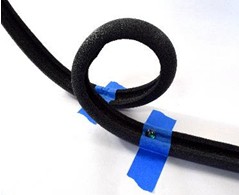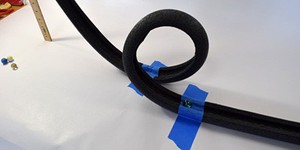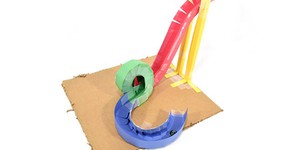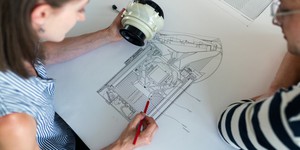Summary
Introduction
How much energy does a roller coaster need to go through a loop without getting stuck? Build your own marble roller coaster in this project and find out!
Materials
- 1.5" diameter foam pipe insulation (at least one 6-foot section)
- Glass marbles or metal ball bearings
- Painter's tape
- Utility knife
- Table or chair
Prep Work
Instructions
- Curl one end of a piece of pipe insulation into a loop, roughly 1 foot in diameter.
- Tape the loop to the floor to hold it in place. Make sure tape is not blocking the inside of the channel (it's OK to tape have tape on the inside, just make sure it is pressed flat and will not block the marble).
- Tape the free end of the pipe insulation to a table or chair, forming a large hill leading down to the loop.
- Place your marble a few inches from the bottom of the hill and release it. Does the marble make it through the loop?
- Move your marble a few inches up the track and release it again. Keep repeating this process until the marble goes the whole way through the loop.How high does the starting position need to be before the marble goes through the loop? Is it lower, the same height, or higher than the top of the loop?
- Expand your coaster! Try adding twists, turns, hills, or more loops. You can make your coaster even taller by taping pieces of pipe insulation together end-to-end. How high do you need to start the marble for it to make it to the end of your coaster?
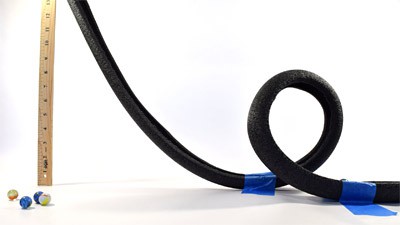 Image Credit: Ben Finio, Science Buddies / Science Buddies
Image Credit: Ben Finio, Science Buddies / Science Buddies
What Happened?
You should have discovered the marble needed to start higher than the top of the loop in order to make it the whole way through the loop. Read the Digging Deeper section to learn why!
Digging Deeper
Roller coasters rely on two types of energy to operate: gravitational potential energy and kinetic energy. Gravitational potential energy* is the energy an object has stored due to its mass and its height off the ground. Kinetic energy is the energy an object has due to its mass and its velocity.
When a roller coaster reaches the very top of its initial hill, it has a lot of potential energy because it is very high off the ground. It moves over the top of the hill very slowly, so it has almost no kinetic energy. Then, it drops down the other side of the hill, and starts going very fast as its height rapidly decreases. The potential energy is converted to kinetic energy. This process repeats as the coaster goes through hills, loops, twists, and turns. Whenever it goes up, it gains more potential energy, but loses kinetic energy as it slows down. Energy is never created or destroyed—it just converts from one form to another. This is known as conservation of energy.
However, we know from experience that a roller coaster can't keep going forever. Eventually it slows down because of friction (a combination of air resistance and friction with the track). If energy isn't created or destroyed, where does that energy go? It is converted into heat. This is why you can rub your hands together to warm them up — friction converts energy from your moving hands into heat!
Because of friction, your marble will always need to start slightly higher than the very top of the loop. Otherwise, it will never have enough energy to make it through the loop without stopping.
* Note: there are other types of potential energy, like elastic, electrical, and chemical. When talking about roller coasters, we usually drop the "gravitational" and just say "potential energy," since it's implied that we aren't talking about the other types.
Ask an Expert
For Further Exploration
- Watch your marble closely and observe its speed. Where is the marble going the fastest? Where is it going the slowest?
- Add a straight piece of track to the end of your roller coaster, at the bottom of the loop. How far does the marble roll before friction brings it to a stop?


